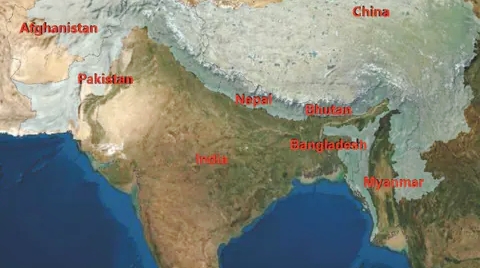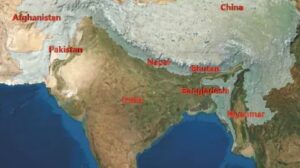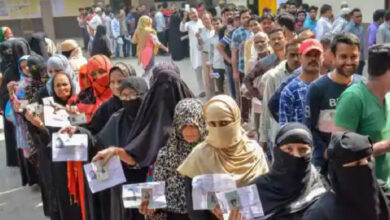भारत-चीन सहित एशियाई 8 देशों में घट रहीं ठंडी रातें, शोध में खुले कई राज bhaarat-cheen sahit eshiyaee 8 deshon mein ghat rahee thandee raaten, shodh mein khule kaee raaj

देहरादून | [उतराखंड बुलेटिन] | वाडिया हिमालयन भू-विज्ञान संस्थान के वैज्ञानिक शोधों के मुताबिक, हिन्दु कुश रीजन में हर दस साल में 0.5 दिन के हिसाब से ठंडी रातों की अवधि घट रही है। विश्व में औसत तापमान की वृद्धि ने हिन्दु कुश और हिमालयी रीजन के देशों को भी चिंतित कर दिया है। इन दोनों रीजन से जुड़े 8 देशों में ठंडी रातों की अवधि कम हो रही है। इसका असर क्षेत्र के तापमान, ग्लेशियर के पिघलने की रफ्तार और प्राकृतिक स्रोतों पर पड़ रहा है।
जबकि 1.7 गर्म रातें प्रति 10 वर्ष में बढ़ रही हैं। वहीं हर दस साल में 1.2 दिन के हिसाब से गर्म दिनों की अवधि भी बढ़ रही है। तापमान वृद्धि का असर हिन्दु कुश, हिमालयी रीजन के 8 देश अफगानिस्तान, बांग्लादेश, भूटान, चीन, नेपाल, म्यांमार, पाकिस्तान और भारत के कुल 3500 किलोमीटर लंबे भूभाग पर पड़ेगा।
इन 8 देशों में कुल 240 करोड़ जनसंख्या निवास करती है। ग्लोबल वार्मिंग के असर से विश्वभर में 1.5 डिग्री सेल्सियस तापमान में औसत बढ़ोतरी की बात सामने आई है, जबकि हिन्दु कुश रीजन में 0.3, हिमालयी रीजन में 0.7 डिग्री सेल्सियस तापमान में औसत वृद्धि का आंकलन है। इससे कराकोरम के मुकाबले सिक्किम, कुमाऊं, गढ़वाल एवं लद्दाख हिमालय के ग्लेशियर (15 मीटर प्रति वर्ष) तेजी से पिघल रहे हैं।
ठंडी रातों की अवधि घट रही
इंटरगवर्नमेंटल पैनल ऑन क्लाइमेट चेंज (आईपीसीसी) ईसीमोड के शोध के अनुसार, पिछले 50 सालों में हिन्दु कुश रीजन में ठंडी रातों में कमी की प्रवृति रही है। शोध के हवाले से वाडिया हिमालयन भू-विज्ञान संस्थान के वैज्ञानिकों ने आंकलन किया है कि इस रीजन में 1901 से 1940 के बीच तापमान की वृद्धि सामान्य से नीचे रही है।
1940 से 1970 के बीच औसत तापमान सामान्य से ऊपर गया। जबकि 1998 से 2014 के बीच के वर्ष पिछले 100 सालों में सर्वाधिक गर्म साल रहे। 1901 से 2020 की अवधि में प्रति 10 साल में औसत तापमान में 0.19 डिग्री सेल्सियस की वृद्धि रही। साल 1951 से 2014 की तुलना करें तो इस दौरान औसत तापमान में वृद्धि 0.20 डिग्री सेल्सियस रही।
खास बातें
- -साल 2019 में ब्रिटेन में वेदर सर्विस ने 38.7 डिग्री सेल्सियस तापमान की भविष्यवाणी की थी। 3 साल बाद हालात बिगड़ गए हैं।
- -फ्रांस के ब्रिटनी क्षेत्र में तापमान 39.3 डिग्री पहुंचा। सितंबर 2003 के बाद हालात बिगड़े। दक्षिण-पश्चिम हिस्सों में गर्मी और बढेगी।
- -राजस्थान के पलोड़ी में 19 मई 1916 को अधिकतम तापमान 51 डिग्री रिकार्ड किया गया। ये भारत का सर्वाधिक रिकार्डेड तापमान है।
यूरोप के मौसम ट्रेंड की तुलना भारत से नहीं हो सकती, वहां के मुकाबले हिन्दुकुश क्षेत्र में ग्रीष्म ऋतु ज्यादा लंबी रहती है। लेकिन इसमें कोई दो राय नहीं, हिंदुकुश रीजन व हिमालयी क्षेत्र में भी तापमान बढ़ रहा है।
डा. कालाचांद साईं निदेशक, वाडिया हिमालयन भू-विज्ञान संस्थान
भारत के नजरिए से देखें तो यहां तापमान में विविधता है। भारत में कई शहरों का तापमान यूरोप के वर्तमान तापमान से ज्यादा हैं, यूरोप में हीट वेब कम होती है, जबकि भारत पहले से ही ऐसा तापमान झेल रहा है।
डा. पंकज चौहान, वरिष्ठ भू-वैज्ञानिक, वाडिया हिमालयन भू-विज्ञान संस्थान

Cold nights are decreasing in 8 Asian countries including India-China, many secrets revealed in research
Dehradun | [Uttarakhand Bulletin] | According to scientific researches of Wadia Institute of Himalayan Geology, the duration of cold nights is decreasing by 0.5 days every ten years in the Hindu Kush region. The increase in the average temperature in the world has also worried the countries of Hindu Kush and Himalayan region. The duration of cold nights is decreasing in the eight countries belonging to these two regions. This is affecting the temperature of the region, the rate of melting of glaciers and natural sources.
While 1.7 hot nights are increasing every 10 years. At the same time, the duration of hot days is also increasing by 1.2 days every ten years. The effect of temperature rise will be on the Hindu Kush, 8 countries of the Himalayan region, Afghanistan, Bangladesh, Bhutan, China, Nepal, Myanmar, Pakistan and India, a total of 3500 km long land.
A total of 240 crore population resides in these 8 countries. Due to the effect of global warming, there has been talk of an average increase in temperature of 1.5 ° C across the world, while the average increase in temperature is estimated to be 0.3 in the Hindu Kush region, 0.7 ° C in the Himalayan region. Due to this, glaciers of Sikkim, Kumaon, Garhwal and Ladakh Himalayas (15 meters per year) are melting faster than Karakoram.
cold nights shortening
According to research by the Intergovernmental Panel on Climate Change (IPCC) ECMod, the Hindu Kush region has had a decreasing trend of cold nights over the past 50 years. Quoting research, scientists of the Wadia Institute of Himalayan Geology have estimated that the increase in temperature in this region between 1901 and 1940 has been below normal.
Between 1940 and 1970, the average temperature rose above normal. Whereas the years between 1998 and 2014 were the hottest years in the last 100 years. In the period 1901 to 2020, there was an increase of 0.19 °C in average temperature every 10 years. Comparing the year 1951 to 2014, the increase in average temperature during this period was 0.20 degree Celsius.
special things
- In the year 2019, the Weather Service in Britain had predicted a temperature of 38.7 °C. After 3 years the situation has worsened.
- The temperature reached 39.3 degrees in the Brittany region of France. The situation worsened after September 2003. The heat will increase further in the south-west parts.
- On 19 May 1916, the maximum temperature of 51 degrees was recorded in Palodi, Rajasthan. This is the highest recorded temperature in India.
The weather trends of Europe cannot be compared with that of India, as compared to the Hindukush region, the summer season is longer. But there is no doubt about it, the temperature is increasing in the Hindukush region and also in the Himalayan region.
Dr. Kalachand Sai Director, Wadia Institute of Himalayan Geology
From India’s point of view, there is variation in temperature here. The temperature of many cities in India is higher than the current temperature in Europe, Europe has less heat web, whereas India is already facing such temperature.
Dr. Pankaj Chauhan, Senior Geologist, Wadia Institute of Himalayan Geology















